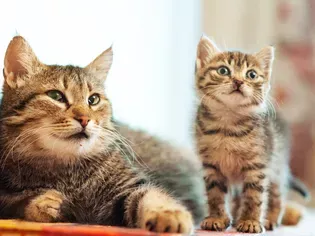Changes Seen During a Cat's Main Stages of Life
Updated on 04/26/24

Embark on a Feline Odyssey: Unraveling the Remarkable Changes Seen During a Cat's Main Stages of Life
Introduction
Cats, our enigmatic feline companions, undergo a captivating journey throughout their lives, exhibiting an array of physical, behavioral, and cognitive changes. From the adorable kittenhood to the graceful senior years, each stage presents unique challenges and transformations. In this comprehensive guide, we delve into the main stages of a cat's life, exploring the remarkable changes that accompany each.
Kittenhood: A Whirlwind of Development
* Birth to 6 Weeks: Blind and deaf at birth, kittens rely heavily on their mother's instincts. They spend most of their time nursing and sleeping.
* 6 Weeks to 12 Weeks: Kittens begin to explore their surroundings, develop their sense of balance, and interact with their littermates. Playful and curious, they display bursts of energy.
* 12 Weeks to 6 Months: Kittens rapidly grow in size and weight. They become more independent, start weaning, and learn social cues from their mother and littermates.
Adolescence: A Time of Transitions
* 6 Months to 12 Months: Kittens enter adolescence, characterized by hormonal changes and increased independence. They establish their own territory, become more vocal, and may exhibit playful aggression.
* 12 Months to 18 Months: Cats reach sexual maturity, becoming capable of reproducing. They may experience behavioral changes, such as marking territory and roaming.
Adulthood: A Period of Stability
* 18 Months to 8 Years: Cats enter adulthood, a period of relative stability. They settle into their routines, become more confident, and may exhibit territorial behaviors.
* 8 Years to 10 Years: Cats begin to show signs of aging, such as decreased energy levels and a slower metabolism. They may also experience changes in their coat, appetite, or sleep patterns.
Senior Years: A Time of Grace and Reverence
* 10 Years to 12 Years: Senior cats experience a decline in physical abilities, but their mental acuity often remains sharp. They may require more attention and support.
* 12 Years and Beyond: Cats enter their geriatric years, characterized by a significant decline in physical and mental abilities. They require special care and consideration in their twilight years.
Specific Changes in Each Stage
Physical Changes:
* Kittens: Rapid growth in size and weight, teething, development of senses.
* Adolescents: Onset of puberty, sexual maturity, establishment of territory.
* Adults: Stabilization of physical attributes, potential changes in weight or coat color.
* Seniors: Decreased energy levels, slowed metabolism, possible loss of muscle mass.
Behavioral Changes:
* Kittens: Playful, curious, dependent on mother and littermates.
* Adolescents: Increased independence, playful aggression, establishment of social hierarchy.
* Adults: Territorial behaviors, routines, vocalization, often affectionate.
* Seniors: Decreased activity levels, increased need for attention, potential cognitive decline.
Cognitive Changes:
* Kittens: Rapid cognitive development, learning through play and observation.
* Adolescents: Development of problem-solving abilities, increased curiosity, and exploration.
* Adults: Peak cognitive function, ability to learn new skills, and strong memory capacity.
* Seniors: Potential decline in cognitive abilities, such as decreased memory and spatial awareness.
Specific Examples
Kittenhood:
* A kitten's ability to climb and jump improves as their motor coordination develops.
* They begin to recognize their mother's voice and littermates' scents.
* They engage in playful behaviors like chasing and pouncing, practicing hunting skills.
Adolescence:
* A young cat may exhibit territorial behaviors by spraying urine or scratching furniture.
* They become more independent, seeking out their own space and playtime.
* They may start to engage in mock fights or play aggression with other cats.
Adulthood:
* An adult cat establishes a regular routine for eating, sleeping, and playtime.
* They become more confident and assertive, protecting their territory from perceived threats.
* They may develop strong bonds with family members and other pets in the household.
Senior Years:
* A senior cat may sleep more and be less active due to decreased energy levels.
* They may experience changes in appetite or thirst, indicating potential health issues.
* They may become more dependent on their human companions for assistance and comfort.
Importance of Understanding the Stages
Understanding the main stages of a cat's life is crucial for:
* Providing Optimal Care: Each stage brings unique needs, from nutrition to health care and socialization.
* Anticipating Changes: Knowing what to expect in each stage helps pet owners prepare for potential behavioral and physical changes.
* Building a Strong Bond: Understanding your cat's changing needs and behaviors strengthens the bond between you and your feline friend.
Conclusion
The journey of a cat's life is a marvel to behold, filled with remarkable changes and transformations. By embracing the different stages of their lives, we can provide them with the love, care, and support they need to live long, happy, and fulfilling lives. As responsible pet owners, it is our duty to cherish these enigmatic creatures and accompany them on their extraordinary journey through life.
Explore More Pets

Cat Behavior Problems
How to Stop Aggression in Kittens

Long-Haired Cat Breeds
Siberian Cat: Breed Profile, Characteristics, & Care

Cat Behavior Problems
How to Stop Kittens From Scratching and Biting

Long-Haired Cat Breeds
Turkish Angora: Cat Breed Profile, Characteristics & Care

Basic Training
How to Socialize Your Kitten

Short-Haired Cat Breeds
Cute Pictures & Facts About Calico Cats & Kittens

Litter Box Training
Training Your Kitten to Use the Litter Box

Long-Haired Cat Breeds
10 Fun Facts About White Cats